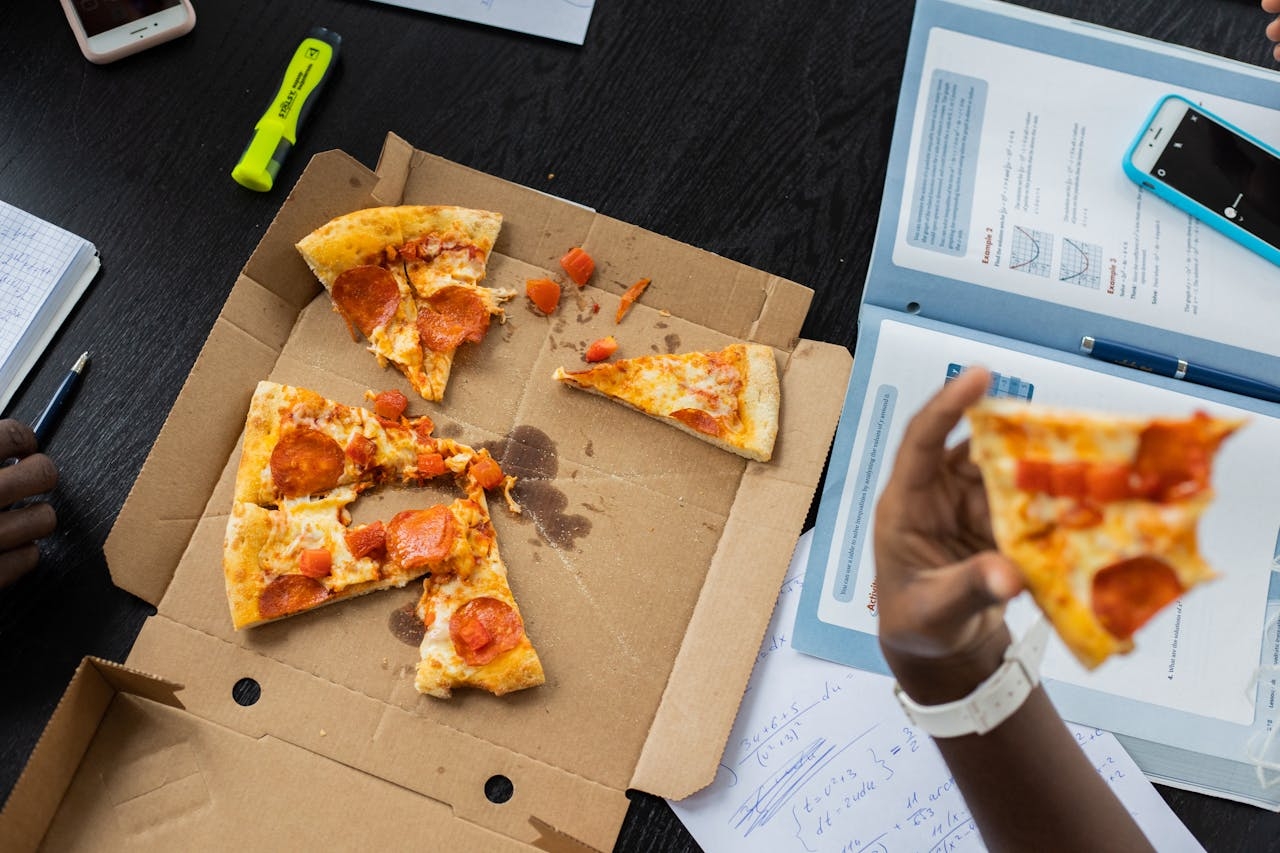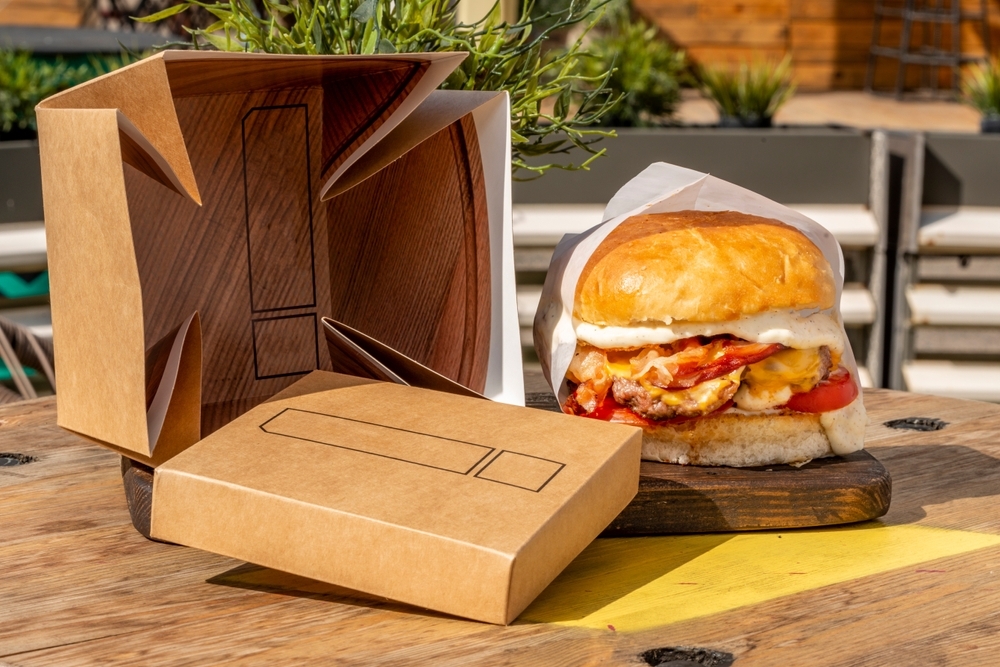Exploring the Best Different Takeaway Packaging Materials for Your Food Business
By Morten Numrich · 25. April 2024
Selecting the right takeaway packaging materials is more than a practicality; it’s a statement of your food business’s commitment to quality and environmental stewardship.
In this comprehensive guide, we dive into different takeaway packaging materials to demystify their functionalities, environmental impacts, and how they can either bolster or tarnish your brand’s reputation.
Choosing the Right Takeaway Packaging Material
 students eating pizza during studies
students eating pizza during studies
When it comes to packaging materials, one size certainly doesn’t fit all.
The conundrum of finding the perfect armor for your edibles—keeping the hot stuff hot, the cold stuff cold, and the brand stuff bold—is no small feat.
Imagine a suit of armor that’s not only tough enough to protect your culinary knights but also chic enough to strut down the runway of customer approval.
It’s a delicate balance between functionality, user-friendliness, and safety, free from the clutches of harmful chemicals.
The food packaging catwalk is diverse, showcasing everything from the classic cardboard boxes to the sleek glass packaging, and even the resilient tin cans, plastic packaging, and pouches; the trend is clear—lighter, cheaper, but still as strong as ever.
Hot Food Packaging
Ever clutched a takeaway so hot it felt like you were holding a piece of the sun? That’s a no-no in the world of effective packaging.
Hot and cold food packaging is as much about keeping your fingers cool as it is about keeping your fries hot. From pizza boxes that are mini saunas for your slices to burger boxes and chip containers, the aim is to keep your comfort food comfortably warm.
Enter the sustainable superheroes: virgin Kraft board and bagasse containers, swooping in to save the day (and the environment) with their compostable might.
In the realm of packaging food, these eco-friendly options are making a significant impact.
And let’s not forget the square food tubs with PE coating for an added heat hug, complete with handles for a smooth getaway—because no one likes a food spill disaster.
Cold Food Packaging
Now, let’s chill. Cold food packaging is the unsung hero that battles against the dastardly villains of moisture and condensation. It’s your shield in ensuring the safety and quality of your frosty treasures.
And for the cold beverages? It’s not just about keeping drinks cool; it’s a crystal-clear window showcasing the liquid gold within to thirsty onlookers.
Customizable Packaging for Branding
Customizable packaging is the secret sauce that maximizes exposure and recognition for your brand. Cardboard📦, that chameleon of packaging materials, can morph into any size, shape, and sport your logo with pride.
Even those eco-friendly packaging providers have jumped on the bandwagon, offering customization that screams your brand without saying a word.
Opting for sustainable packaging is not just a nod to eco-friendliness; it’s a shout from the rooftops that can attract the green-hearted crowd to your culinary doorstep.
Eco-Friendly Takeaway Packaging Options
 Eco-friendly Food Packaging
Eco-friendly Food Packaging
Let’s talk about the green scene. The eco-friendly revolution is here, and it’s packing a punch in the food industry. It’s about finding that sweet spot where hygienic meets healthy for both customers and the planet.
With restaurants being significant contributors to municipal solid waste, the push for eco-friendly options is more crucial than ever.
So let’s be kind to Mother Earth with sustainable food packaging options that include the biodegradable, the compostable, and the recyclable.
It’s about using renewable materials that not only do the job but also woo the eco-conscious market, minimizing waste and winning hearts.
Biodegradable Containers
Plant-based materials are the rock stars of the biodegradable world, breaking down over time to rock out with the earthworms.
Bagasse and NatureFlex are the groupies, derived from sugarcane and wood pulp, respectively, and they’re not just passing fads—they’re here to stay, decomposing without a fuss.
These containers are the environmental equivalent of a standing ovation, ditching fossil fuels and reducing landfill waste.
And they come in all shapes and sizes, catering to a smorgasbord of food items with an environmentally friendly, eco-friendly flourish.
Compostable Packaging
Compostable packaging is like a magic trick, disappearing into non-toxic organic matter right before your very eyes.
If it’s certified compostable, you can bet it will go from packaging to plant food in your home compost in six months or even quicker in commercial composting conditions.
And when it comes to hot foods, there are PLA lined kraft paper bowls that are up for the task, complete with optional PET lids to keep things steamy.
Recycled Paper and Cardboard Products
Recycle, reuse, and reduce never looked so good with recyclable cardboard food boxes.
These eco-warriors come in all sorts of disguises, from grab bags to premium burger boxes, all with a 100% recycled secret identity.
And let’s not forget corrugated packaging, the phoenix rising from the ashes of trees and old moving boxes to be reborn as new, sustainable packaging—talk about a circular economy superstar.
For an even better environmental impact, consider the following:
- Reflect on the material composition, including other materials, and recyclability of your current packaging
- Identify areas for improvement
- Implement changes to further reduce carbon emissions
Innovative and Sustainable Takeaway Packaging Solutions
 biodegradable recyclable custom packaging box
biodegradable recyclable custom packaging box
The packaging innovation train is not slowing down anytime soon, with new sustainable solutions popping up faster than you can say “eco-friendly”🌱.
Brands that tout their sustainable packaging are like the cool kids on the block, attracting a loyal following of customers who prefer their meals served with a side of environmental responsibility.
Edible Packaging
Imagine a world where you can have your packaging and eat it too—welcome to the realm of edible packaging.
This isn’t just a quirky gimmick; it’s a growing industry, with a market that’s set to expand like dough in a warm oven.
We’re talking everything from starch-based cupcake wrappers to edible straws and spoons, crafted with care from plant-derived ingredients. And who knows, maybe one day we’ll even see edible bubble wrap!
The edible coffee cups, for instance, stay strong for your sipping pleasure, and the edible spoons can take on a hearty meal without buckling under the pressure.
And for the sweet tooths out there, rice wafer paper candy wrappers mean you can gobble up your candy and its packaging without a trace of waste.
Reusable Containers
But what about going beyond disposal? Enter reusable containers, the knights in shining armor of the zero-waste movement.
These trusty vessels are all about the long game, trading single-use for multi-use and saving both the environment and your wallet.
To get the ball rolling, businesses need to think about the logistics—from the return and sanitization of containers to educating staff and customers about the program.
Plant-Based Plastics
And then there’s the new kid on the block: plant-based plastics. Made from materials like corn, sugar cane, or bamboo, these plastics are not just compostable, they’re a glimpse into the future of sustainable packaging, offering an alternative to non recyclable materials.
Frequently Asked Questions
What makes packaging materials eco-friendly?
Eco-friendly packaging materials are characterized by their biodegradability, compostability, and recycled content, reducing our reliance on fossil fuels and lessening waste in landfills.
Can packaging really impact a food business’s brand image?
Yes, packaging can significantly impact a food business’s brand image by increasing exposure, recognition, and attracting eco-conscious customers.
Are there any packaging options that are both edible and sustainable?
Edible packaging made from seaweed or starch is a fantastic no-waste option that is both consumable and biodegradable.
How can a business transition to sustainable packaging without breaking the bank?
Transitioning to sustainable packaging without breaking the bank involves assessing current packaging, working with suppliers for cost-effective options, and communicating a commitment to sustainability.

